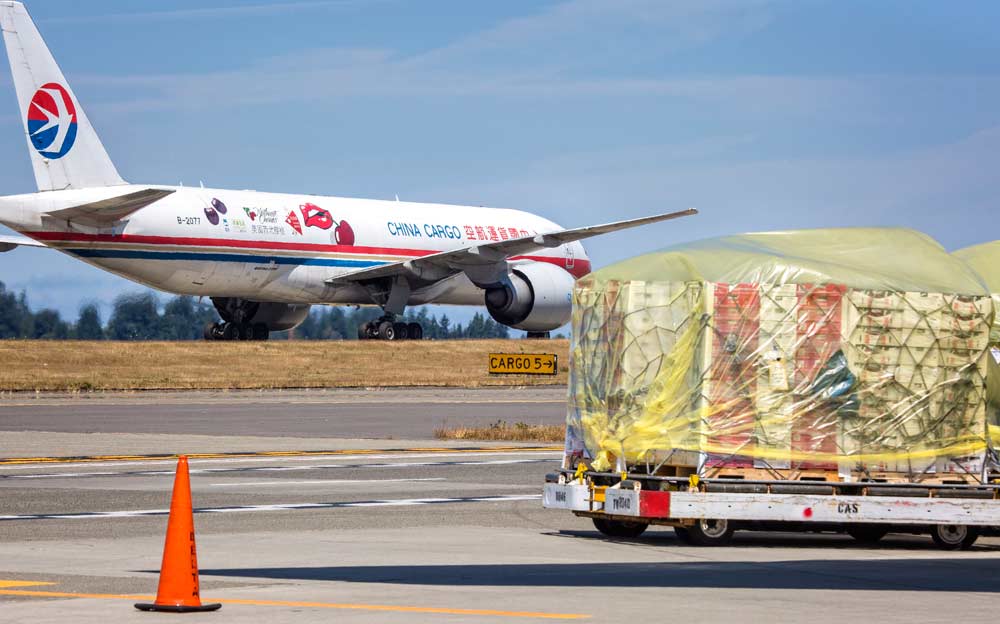
The Cherry Express plane arrives at the cargo departures area of SeaTac airport in Seattle, Washington, on July 12, 2017, to take fresh cherries to the Chinese market, while other Northwest cherries bound for Korea, right, are staged for loading. Eight international cargo flights were packaged and loaded from the neutral apron loading areas at SeaTac scheduled for markets across Asia. (TJ Mullinax/Good Fruit Grower)
Freight crew shifts last 26 hours. Employees sign up for seven-day workweeks to bank double time. Airlines double, triple, quadruple the frequency of their cargo flights.
Northwest cherries may have had a rough year with warehouses turning away small fruit, but exports continued to soar from the runways of Seattle-Tacoma International Airport, providing a much-needed release valve for the sluggish domestic market.
“It’s very hectic,” said Vilipapa Manu, a freight crew manager as she sorted pallet after pallet of outbound fruit in July. “Too many cherries.”
Northwest cherry exports took off in 2017
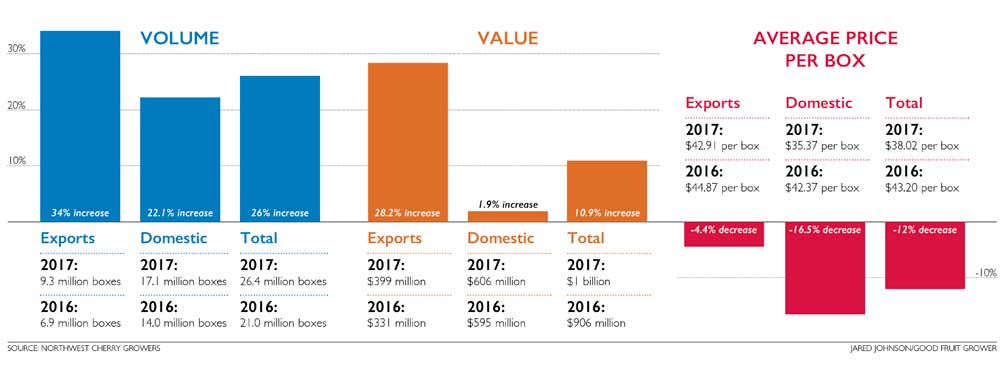
2017’s record cherry harvest was more than 25 percent larger than the previous year. But while the domestic market saw a big drop in the average price per box, high export prices — helped by cherry-loving consumers in China and other parts of Asia — pushed the total value of the crop to $1 billion for the first time. (Source: Northwest Cherry Growers. Jared Johnson/Good Fruit Grower)
The 2017 cherry export volume increased 34 percent over 2016, according to Northwest Cherry Growers statistics, while export values jumped 28 percent. Yes, growers harvested a record crop overall, but that explains only some of the surge. Overall volume and value didn’t increase that much. Meanwhile, average prices per box dropped way less for exports than domestic cherries.
Keith Hu, international program director of Northwest Cherry Growers, is not surprised. “The industry’s confidence level in overseas markets was pretty high based on the very positive feedback gathered from the key foreign business partners before the 2017 … season,” he said. “High demands were expected from Australia, Canada, China, Mexico, Southeast Asia, South Korea and Taiwan.”
In all, exports helped the Northwest cherry crop hit $1 billion in value for the first time.
Based in Yakima, Washington, Northwest Cherry Growers is an industry association that markets cherries from the states of Washington, Oregon, Idaho, Montana and Utah.
Also not surprisingly, China accounted for the biggest jump, with a 61 percent increase over 2016, pushing the country for the first time to the top of the export list ahead of Canada.
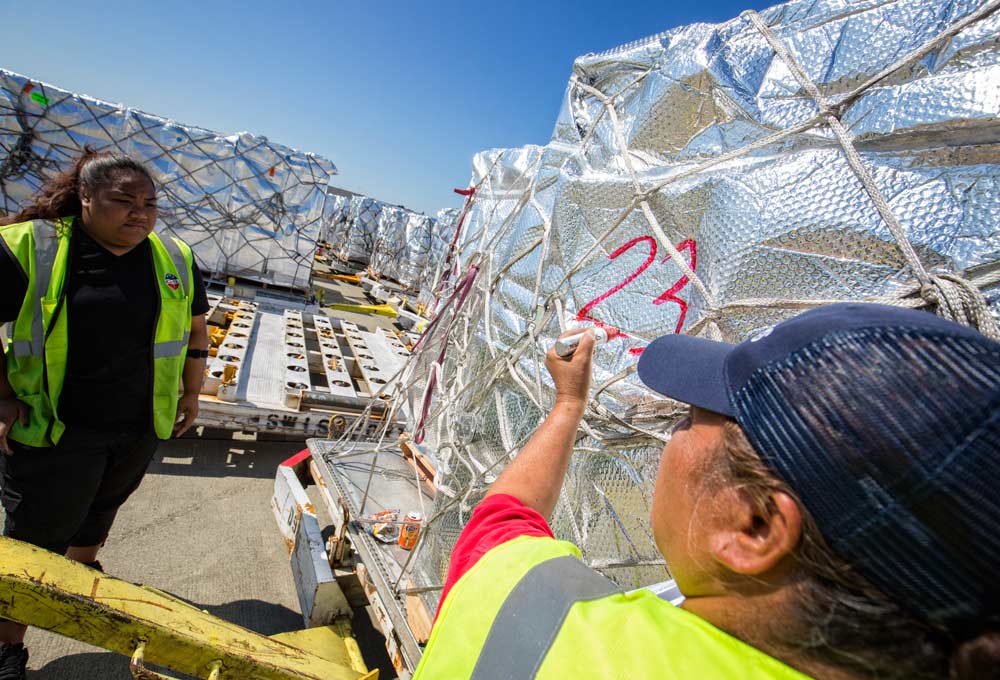
Vilipapa Manu, right, marks a wrapped container of fresh Pacific Northwest cherries as the 23rd of 26 containers to be loaded onto a aircraft heading to China out of the international cargo departures area of SeaTac airport in Seattle, Washington, on July 12, 2017. (TJ Mullinax/Good Fruit Grower)
The market has been growing for some time, too, with the efforts of Northwest Cherry Growers paying dividends. The 2017 export volume to China was five times that of 2009.
“All along we knew the potential of the Chinese market was great,” Hu said. “We have done a pretty good job developing the first-tier cities in the past years. About four years ago, we started to develop the key second-tier cities, and this year we saw the impact of the second-tier cities.”
Chinese customers simply love Northwest cherries, said Catherine Wang, North American general manager of China Cargo Airlines as she supervised the loading of a Boeing 777. “In China, we don’t care if it’s expensive. We just want the quality.”
Busy days at Sea-Tac
Almost all fresh cherries are exported by plane, which meant busy days this past summer on the cargo ramps at Sea-Tac, where pallets wrapped in cold-preserving foil awaited their turn for a flight. Labels bore familiar industry names such as Chelan Fresh, CMI Orchards and Stemilt Growers.
Manu and her crews used conveyor belts and rollers to inch the pallets from the pavement onto elevators that raised them to fuselage doors. Then, another set of belts and rollers towed them inside the plane.
The fast-paced schedule aims to move perishable cherries quickly to the hands of customers.
Picked in the early morning, the fruit usually makes it through packing and trucking to a Sea-Tac area warehouse by night, where airport freight crews start organizing them for the upcoming flights beginning in the wee hours of the next morning.
If everything goes right, those flights arrive in Seoul or Shanghai and make it through the infrastructure to distribution centers, stores and customers in as little as 48 hours.
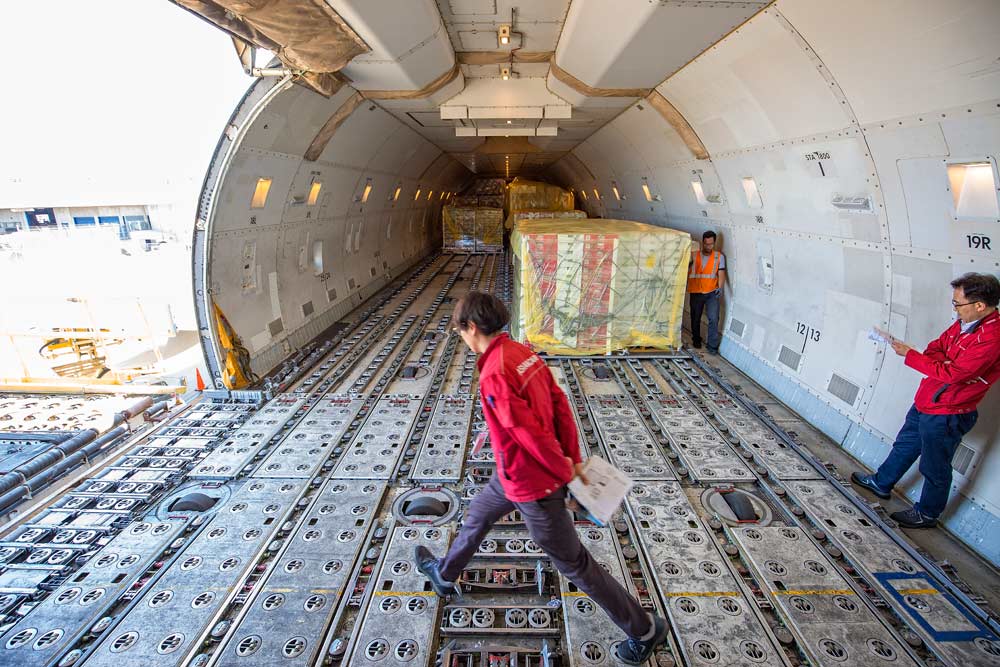
Hyun Chang Kim, station manager for Asiana Airlines, Inc., walks across the deck of a Boeing 747 cargo jet while the first of several Pacific Northwest cherries containers are loaded into the aircraft. Kim ensures all fruit is securely loaded by his crew that will largely be filled with cherries bound for markets in Korea. (TJ Mullinax/Good Fruit Grower)
In fact, the Cherry Express plane advertises as much in both English and Chinese with an icon near its tail. Through a promotion with Northwest Cherry Growers and online giant Alibaba, the China Cargo Airlines plane serves as a flying billboard bearing pictures of cherries and a cartoon mouth strangely reminiscent of the Rolling Stones’ “hot lips” logo.
First, though, the flights have to line up on schedule.
“If they’re on time, we’re good,” Manu said. “If they’re not on time, that’s when we run into problems.”
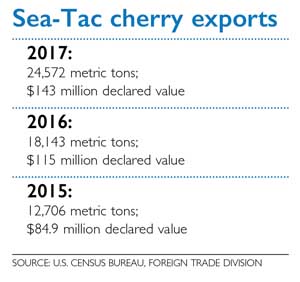
Cherry exports in volume and value through Seattle-Tacoma International Airport from 2015-2017. (Source: U.S. Census Bureau, Foreign Trade Division)
Some international carriers that don’t have enough capacity on their own planes charter freighter flights or sublease planes directly from the likes of Atlas Air, and Kalitta Air, which operate cargo-only fleets. That was more common this year. In 2015, cherries were already the top export product out of Sea-Tac, accounting for 5 percent of total airfreight for the year; 2017 saw twice the volume.
To keep up with rising exports, the airport made a $20 million expansion to the air cargo deck, increasing the size of the 18 hard stands — freight plane parking spaces. However, growth in the passenger side of operations may encroach and reduce the number of hard stands over the next 10 years under a plan considered by the Port of Seattle commissioners, said Tom Green, senior manager for air cargo operations and development at the Port of Seattle.
“It would really only hurt us if we use all 18 at a peak,” he said. “… That’s rare, that you’re going to have a freighter in every position.”
However, the plan also calls for increasing the square footage of the air cargo buildings, which would help exports.
Not just China
Shoppers in Asian countries outside of China are excited for cherries, too, with pronounced growth in Taiwan, Thailand, Singapore and Malaysia. Industry stalwart South Korea was one of the few places where consumption dipped, but just barely. Hu still considers Korea an overall steady market.
“There is growth to be tapped in the central and southern regions of South Korea,” he said. “There are many reasons why South Korea took a dip this year, but it is more important for the industry to have a healthy South Korean market than breaking records every season.”

Thousands of pounds of Northwest grown cherries wait to be loaded into eight international cargo flights from the neutral apron loading areas at SeaTac International airport scheduled for markets in Asia on July 12, 2017. (TJ Mullinax/Good Fruit Grower)
South Korean carrier Asiana Airlines stopped to finish loading up the fuselage of a 747. Overseeing the work, station manager Hyun Chang Kim instructed crews to cram other products toward the front and rear of the plane, leaving room for 18 pallets of cherries.
“You can see, I emptied this whole plane so I can fill it up with cherries,” said Kim, a personal fan of Rainiers.
It was the first of two flights that day. The second one would carry only cherries.
“In cherry season, we double our frequency, for sure,” Kim said. More than that, actually. During cherry season, the airline’s flights to Incheon, South Korea, spiked from three per week to 11. •
by Ross Courtney






Leave A Comment